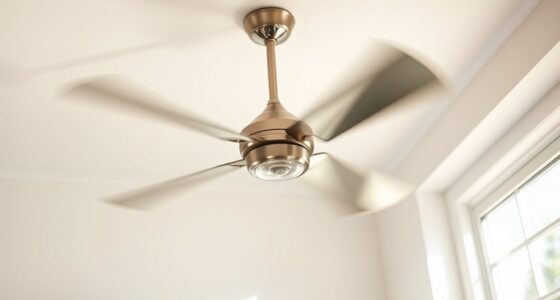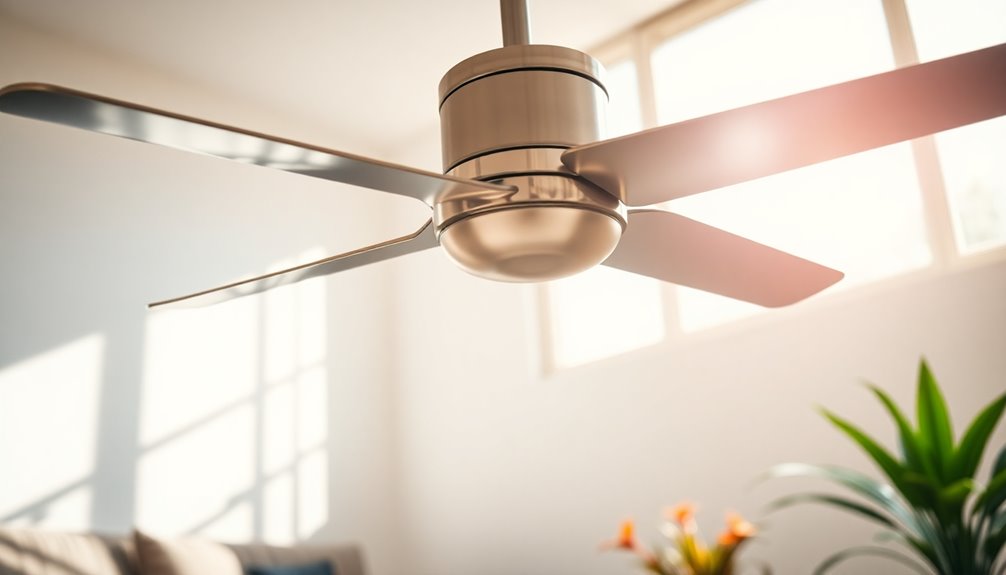Fan EnergyGuide labels help you understand a fan’s energy use, efficiency, and performance. They show annual electricity consumption, airflow (CFM), noise levels, and standards compliance. The efficiency range indicates how well a fan performs relative to energy use, helping you compare models and find cost-effective choices. Paying attention to these details can save you money and energy over time. Keep going to discover how to make the best decisions with these labels.
Key Takeaways
- The label displays annual energy consumption in kilowatt-hours (kWh) to compare fan efficiency.
- It includes efficiency ratings based on airflow (CFM), noise levels, and compliance with ventilation standards.
- Range indicators show the spectrum from less to more energy-efficient models, aiding in selection.
- Estimated yearly energy costs help evaluate ongoing expenses and potential savings.
- Practical tips include checking noise levels, airflow, and compatibility to choose energy-efficient, suitable fans.
What Are Fan EnergyGuide Labels?

Fan EnergyGuide labels are standardized stickers attached to ceiling fans and other types of fans to provide important energy efficiency information. These labels help you compare models based on their energy consumption and efficiency, making it easier to choose an energy-saving fan. When installing your fan, follow installation tips to guarantee it operates safely and efficiently. Proper installation minimizes energy waste and reduces wear on components. Maintenance practices are equally important; regularly cleaning the blades and checking for loose parts keep your fan running smoothly and efficiently. The label offers quick insights into the fan’s energy use, but maintaining your fan assures it performs at its best over time. Understanding these labels helps you make smarter choices, saving energy and lowering your utility bills. Additionally, being aware of Fan EnergyGuide labels can help in selecting models that are more environmentally friendly and cost-effective over their lifespan. Recognizing the significance of energy efficiency ratings can further assist in making sustainable choices that benefit both your wallet and the environment.
Key Information Displayed on the Labels
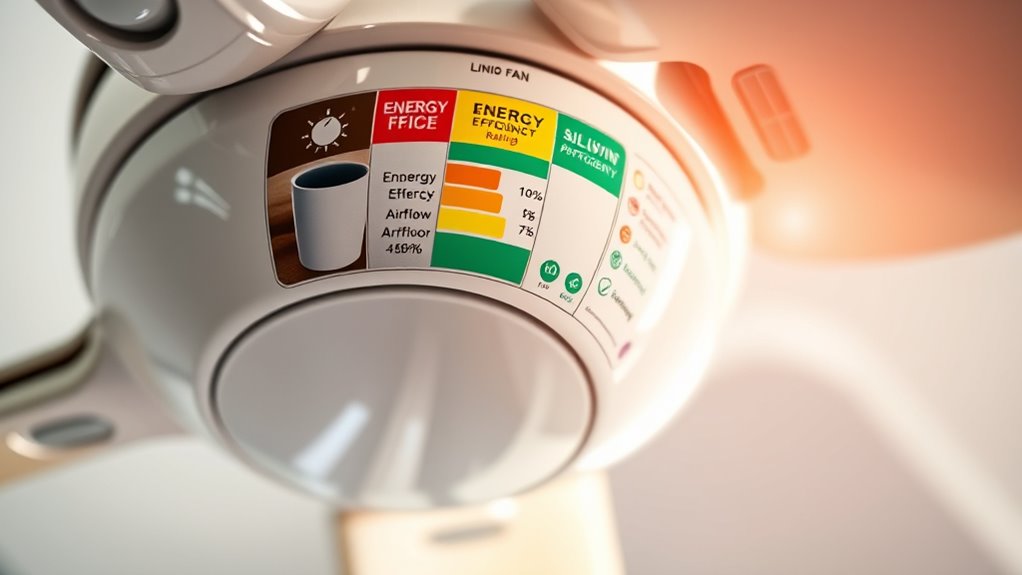
On a Fan EnergyGuide label, you’ll find important details like energy consumption data and efficiency ratings. These figures help you compare fans quickly and identify the most energy-efficient options. Understanding this information makes it easier to choose a fan that saves energy and lowers costs. Being aware of energy efficiency ratings can also guide you in selecting products that contribute to a more sustainable lifestyle. Additionally, awareness of automation in business highlights how technological advancements can influence energy use and operational efficiency.
Energy Consumption Data
Have you ever wondered how much energy your ceiling fan uses? The Energy Consumption Data on the label helps you understand this. It shows the estimated energy use in kilowatt-hours (kWh) annually, giving you a clear idea of running costs. This info helps you compare fans and choose models with better airflow optimization and quieter operation. By looking at the data, you can select a fan that balances effective airflow with noise reduction, ensuring comfort without wasting energy. Remember, lower energy consumption not only saves you money but also reduces your environmental impact. Keeping an eye on these figures guides you toward more efficient choices, helping you run your fan effectively while minimizing unnecessary energy use. Additionally, understanding Self Watering Plant Pots can inform safer technology choices in smart home devices. Moreover, selecting fans with energy-efficient motors can further reduce your energy footprint.
Efficiency Ratings Display
Efficiency ratings on the label quickly tell you how well a ceiling fan performs relative to its energy use. This display highlights key factors like airflow efficiency, noise level, and compliance with ventilation standards. Higher ratings mean better performance with less energy and quieter operation. The label helps you compare fans easily, ensuring you choose a model that meets your needs. It also indicates noise levels, so you can find fans that operate quietly without sacrificing airflow. Ventilation standards are referenced to confirm the fan’s compliance. Here’s a quick overview: Understanding ventilation standards can help you assess a fan’s overall efficiency and suitability for your space.
| Rating Aspect | Description | Typical Range |
|---|---|---|
| Airflow Efficiency | How well the fan moves air per watt | 75-125 cfm/watt |
| Noise Level | Sound emitted during operation | 50-70 dB |
| Ventilation Standards | Compliance with regulations | Yes/No |
How to Read the Energy Consumption Numbers

Understanding the energy consumption numbers on your Fan EnergyGuide label is key to making informed decisions. These figures show how much electricity your fan uses, typically measured in kilowatt-hours (kWh) annually. By comparing these numbers, you can evaluate which fan consumes less energy and saves you money over time. Keep in mind that a fan’s energy use affects your ventilation system’s efficiency, impacting airflow and overall performance. While reading the numbers, also consider noise levels, as a quieter fan might be preferable even if it uses slightly more energy. Remember, the goal is to balance energy efficiency with comfort and functionality, ensuring your ventilation system operates effectively without unnecessary energy waste. Energy efficiency can be improved by choosing fans with optimal power consumption, which also supports sustainable practices. Additionally, selecting fans with smart features or auto functions can optimize energy use based on real-time needs, leading to better energy management and reduced consumption.
Understanding the CFM and RPM Ratings

CFM (cubic feet per minute) and RPM (revolutions per minute) are key ratings that reveal how well a fan moves air and how fast its blades spin. Higher CFM means better airflow, which is essential for airflow enhancement in a space. RPM indicates the blade speed, affecting both airflow and noise levels. A fan with a high RPM may move air quickly but can be noisier, so balancing CFM and RPM helps you choose a fan that delivers sufficient airflow without excessive noise. Understanding these ratings helps you select a fan suited to your needs, whether for quiet operation or maximum air movement. Additionally, Kia Tuning techniques can influence airflow performance in vehicle systems, highlighting the importance of optimized airflow management. Recognizing the relationship between airflow efficiency and fan ratings can further assist in making an informed choice, especially when considering fan performance metrics that impact overall effectiveness.
The Significance of the Energy Efficiency Range

The energy efficiency range on the label shows you how well a fan performs in regard to energy use. Range indicators help you compare models and understand their potential savings. Recognizing these signs allows you to choose fans that save money and reduce energy consumption. Additionally, understanding sound therapy science can inform you about how different models may produce varying noise levels during operation. Incorporating energy-saving features can further enhance your ability to select the most efficient fan for your needs. Being aware of the essential oils for respiratory health can also guide you in selecting models with quieter operation to enhance your comfort.
Range Indicators’ Meaning
Range indicators on Fan EnergyGuide Labels reveal how energy-efficient a fan truly is by showing where it falls within a spectrum from less efficient to more efficient models. This helps you quickly compare fans and identify those that save energy and reduce costs. A higher efficiency rating typically means the fan operates more quietly, which can lower fan noise and create a more comfortable environment. When choosing a fan, consider installation tips that ensure proper setup, as incorrect installation can affect both noise levels and efficiency. Understanding the range indicator guides you to select models that balance performance with energy use, helping you make smarter, long-term decisions. Additionally, proper tuning of the fan system can optimize its performance and energy savings. Environmental considerations such as minimizing impact on nature and following safety regulations also play a role in sustainable fan use. Recognizing how energy efficiency ratings reflect a fan’s overall performance can further aid in selecting the most suitable model. Ultimately, these indicators give you a clear picture of a fan’s efficiency potential at a glance.
Energy Savings Potential
Understanding the energy efficiency range on Fan EnergyGuide Labels helps you recognize the potential savings a fan can offer over time. Fans with higher efficiency ratings use less energy, leading to lower operating costs and more cost-effective upgrades. By choosing a fan within this range, you can reduce your electricity bills and enjoy long-term savings. Additionally, energy-efficient fans have a smaller environmental impact because they consume less power, helping you reduce your carbon footprint. This makes selecting a fan with a better energy efficiency range a smart decision for both your wallet and the planet. Recognizing this potential encourages you to prioritize models that maximize energy savings, ensuring your investment delivers maximum benefits over the fan’s lifespan.
Comparing Fans Using the Labels

When comparing fans using the EnergyGuide labels, you’ll find that these labels provide clear, essential information to help you make an informed decision. The labels highlight key data such as energy consumption, airflow, and efficiency, making it easier to evaluate options. To compare effectively, consider these points:
- Check the estimated yearly energy cost to understand ongoing expenses.
- Look at the airflow ratings to ensure adequate ventilation standards for your space.
- Review noise levels, as quieter fans can improve comfort without sacrificing performance.
Tips for Choosing the Most Efficient Fan

To choose the most efficient fan, start by examining the EnergyGuide label carefully. Look for models with lower energy consumption ratings, which indicate better efficiency. Consider how the fan fits into your smart home setup; some models are compatible with smart controllers, allowing remote adjustments and scheduling. Pay attention to noise levels listed on the label or product specifications—quieter fans enhance comfort, especially in bedrooms or living spaces. Choose a fan with adjustable speed settings, so you can optimize energy use based on your needs. A more efficient fan not only reduces your energy bills but also minimizes environmental impact. By comparing ratings and features, you can select a fan that offers excellent performance, integrates seamlessly into your smart home, and operates quietly.
Benefits of Paying Attention to Energy Ratings
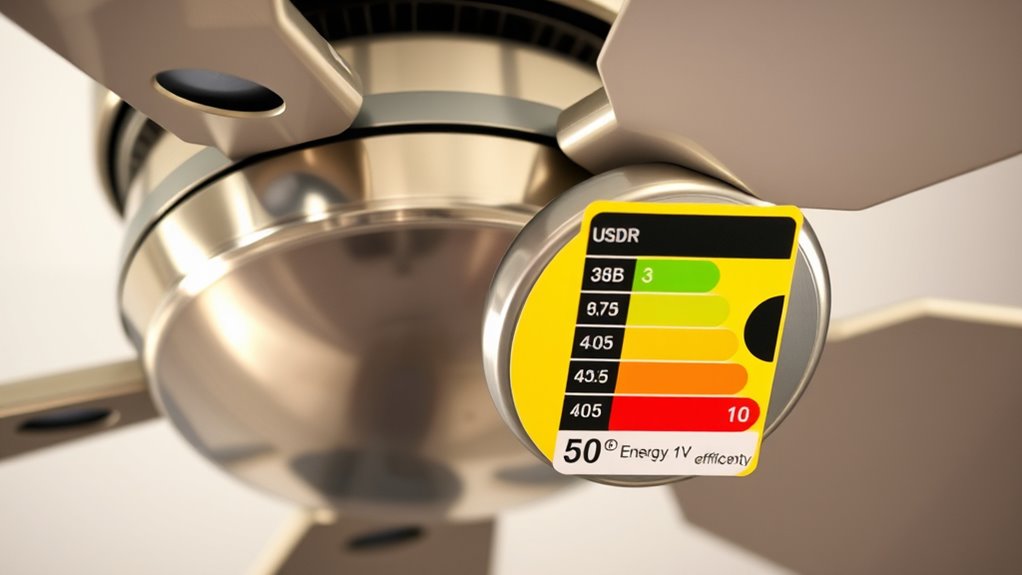
Paying attention to energy ratings on fan labels can lead to significant savings on your utility bills over time. Higher-rated fans often meet ventilation standards more efficiently, reducing energy waste. By choosing energy-efficient fans, you also lower your environmental impact, helping to conserve resources. Here are some benefits:
Choosing energy-efficient fans saves money, reduces waste, and supports eco-friendly living.
- Save money on electricity bills with lower energy consumption.
- Support environmental sustainability by reducing carbon footprint.
- Ensure better indoor air quality and ventilation performance.
Focusing on these ratings helps you select fans that are both cost-effective and eco-friendly. Additionally, understanding energy labels encourages smarter choices aligned with energy standards, promoting healthier living environments. Ultimately, paying attention to energy ratings benefits your wallet and the planet.
Common Misconceptions About Fan Labels
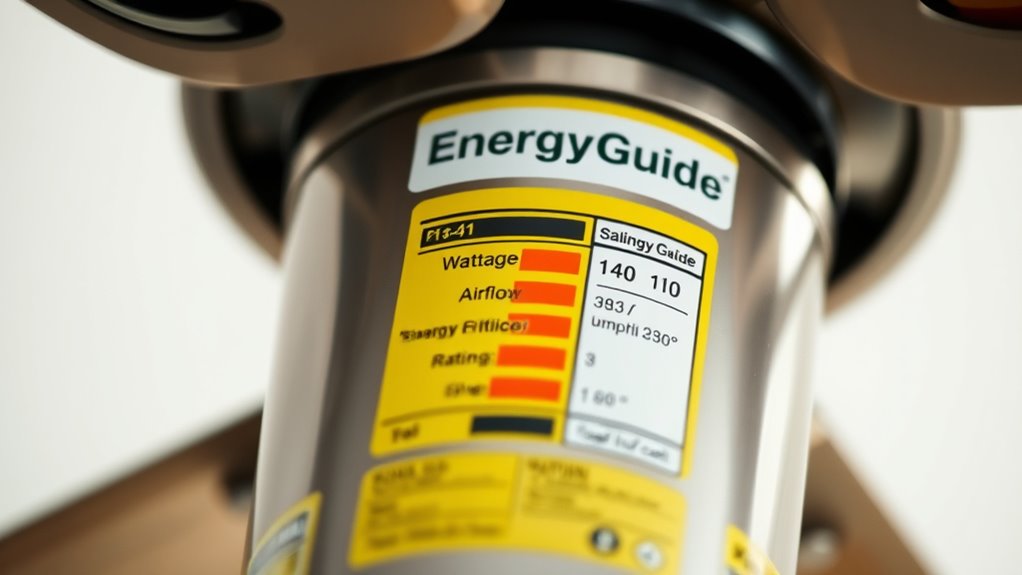
Many people assume that all fan labels are straightforward indicators of energy efficiency, but that’s not always true. Some believe a high-efficiency label means the fan operates quietly, yet fan noise varies regardless of the label. Similarly, many think that installation costs are minimal or unrelated to the label; however, more complex or larger fans often have higher installation costs. It’s a misconception that the label guarantees ideal performance in every aspect. Labels primarily focus on energy usage, not noise levels or installation expenses. You should consider fan noise ratings separately and consult professionals to understand potential installation costs. Relying solely on labels can lead to surprises, so do your research beyond the EnergyGuide to find the best fan for your needs.
Frequently Asked Questions
How Often Are Fan Energyguide Labels Updated or Revised?
You might wonder how often the fan EnergyGuide labels get updated or revised. Typically, the label update frequency depends on regional labeling standards, which can vary. Manufacturers follow these standards, so updates happen when standards change or new models are released. It’s a good idea to check for the latest labels periodically, especially if you’re comparing energy efficiency, since regional standards influence how often labels are revised.
Do Labels Indicate Noise Levels or Only Energy Consumption?
Fan EnergyGuide labels primarily focus on energy consumption, helping you compare efficiency across models. They don’t directly indicate noise levels or provide a noise comparison. However, some labels may include estimated noise information, but it’s not standardized. If noise levels matter to you, check product specifications or reviews for noise comparison details. This helps you choose a fan that balances energy savings with acceptable noise performance.
Can a Higher CFM Rating Mean a Louder Fan?
Yes, a higher CFM rating can mean a louder fan, but it depends on the model and design. When comparing fans, consider noise levels for a better noise comparison, especially if quiet operation matters to you. Keep installation considerations in mind, as proper setup can reduce noise. Remember, a more powerful fan might move more air but could also produce more sound, so balance your airflow needs with noise tolerance.
Are There Regional Differences in Labeling Standards?
You might think regional standards don’t matter, but they do influence label variations. Different areas may have unique energy efficiency rules, leading to variations in how fans are rated and labeled. This means a fan’s EnergyGuide label could look different depending on where you’re shopping. So, always check regional standards to compare models accurately and make sure you’re choosing the most energy-efficient fan for your climate and local regulations.
How Do Maintenance Practices Affect a Fan’S Energy Efficiency?
Maintenance impact greatly affects a fan’s energy efficiency. When you regularly clean blades and check for dust buildup, you reduce strain on the motor and improve airflow. Efficiency practices like lubricating parts and replacing worn components ensure the fan runs smoothly. Neglecting these practices causes increased energy consumption and decreased performance. By staying proactive with maintenance, you maximize your fan’s efficiency, save energy, and extend its lifespan.
Conclusion
Think of Fan EnergyGuide labels as a map guiding you through the landscape of efficiency. By understanding the details, you can navigate toward the most energy-savvy choice, saving money and reducing your carbon footprint. Don’t let the labels be a mystery—use them as your compass to find fans that work smarter, not harder. When you decode these signals, you’re steering your home toward a greener, more efficient future with confidence.



